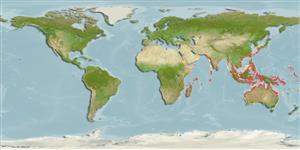>
Carangaria/misc (Various families in series Carangaria) >
Latidae (Lates perches)
Etymology: Psammoperca: Greek, psammos = sand + Greek,perke = perch (Ref. 45335).
More on author: Cuvier.
Environment: milieu / climate zone / intervalo de profundidade / distribution range
Ecologia
marinhas; estuarina associadas(os) a recifes; intervalo de profundidade 3 - 12 m (Ref. 90102). Tropical
Indo-West Pacific: Bay of Bengal, Indo-Australian Archipelago and northern Australia to the Philippines, China Sea and Japan (Ref. 2334). Found in the Mekong delta (Ref. 12693).
Length at first maturity / Tamanho / Peso / Idade
Maturidade: Lm ?, range 28 - ? cm
Max length : 47.0 cm TL macho/indeterminado; (Ref. 2334); common length : 25.0 cm TL macho/indeterminado; (Ref. 9799)
Espinhos dorsais (total) : 8; Raios dorsais moles (total) : 12 - 14; Espinhos anais: 3; Raios anais moles: 8; Vértebras: 14. This species is distinguished from Psammoperca datnioides by the following set of characters: Colouration: when alive, the head and body brownish dark and often golden in colour; pored lateral-line scales yellow-edged; and similar yellowish brown colour in preserved specimens; lower counts of pored lateral line scales 46-48; hind margin of maxilla reaching slightly short of hind margin of eye when mouth closed; tiny scales that are not seen with naked eye, but visible through binocular scope, on the posterior uppermost part of maxilla; pelvic-fin spine subequal to 4th dorsal spine; circumpeduncular scale 21-22; moderately lesser body depth, 32-36% (mean 36%) of SL; lower counts, 5½ / 7½-9½ scale rows above and below lateral line; gill rakers 7 (including 6 rudiments) + 1 + 11 (including 3 rudiments) = 19 (9 rudiments); last dorsal-fin spine / penultimate dorsal-fin spine 1.5-1.7 (Ref. 124584).
Body shape (shape guide): fusiform / normal; Cross section: compressed.
Inhabits rocky or coral reefs, frequently in weedy areas, usually in holes and crevices by day. Enters estuaries (Ref. 4833). Forages on fishes and crustaceans at night (Ref. 9710). Mainly marketed fresh. In Hong Kong sold live in fish markets (Ref. 27253).
Life cycle and mating behavior
Maturidade | Reprodução | Desova | Ovos | Fecundidade | Larvas
Iwatsuki, Y., S.J. Newman, F. Tanaka and B.C. Russell, 2018. Validity of Psammoperca datnioides Richardson 1848 and redescriptions of P. waigiensis Cuvier in Cuvier & Valenciennes 1828 and Hypopterus macropterus (Günther 1859) in the family Latidae (Perciformes) from the Indo-West Pacific. Zootaxa 4402(3):467-486. (Ref. 124584)
Categoria na Lista Vermelha da IUCN (Ref. 130435: Version 2025-1)
Ameaça para o homem
Harmless
Utilização humana
Pescarias: espécies comerciais; peixe desportivo: sim
Ferramentas
Relatórios especiais
Descarregue XML
Fontes da internet
Estimates based on models
Preferred temperature (Ref.
123201): 24.7 - 29.3, mean 28.4 °C (based on 2981 cells).
Phylogenetic diversity index (Ref.
82804): PD
50 = 0.7501 [Uniqueness, from 0.5 = low to 2.0 = high].
Bayesian length-weight: a=0.01047 (0.00491 - 0.02235), b=3.02 (2.83 - 3.21), in cm total length, based on LWR estimates for this (Sub)family-body shape (Ref.
93245).
Nível Trófico (Ref.
69278): 4.0 ±0.67 se; based on food items.
Resiliência (Ref.
120179): Médio, tempo mínimo de duplicação da população 1,4 - 4,4 anos (Preliminary K or Fecundity.).
Fishing Vulnerability (Ref.
59153): Moderate vulnerability (37 of 100).
🛈
Nutrients (Ref.
124155): Calcium = 57.9 [28.1, 102.6] mg/100g; Iron = 0.579 [0.300, 1.063] mg/100g; Protein = 20 [18, 22] %; Omega3 = 0.14 [0.09, 0.21] g/100g; Selenium = 24.4 [13.5, 47.5] μg/100g; VitaminA = 62.7 [17.8, 226.9] μg/100g; Zinc = 1.19 [0.81, 1.83] mg/100g (wet weight);
